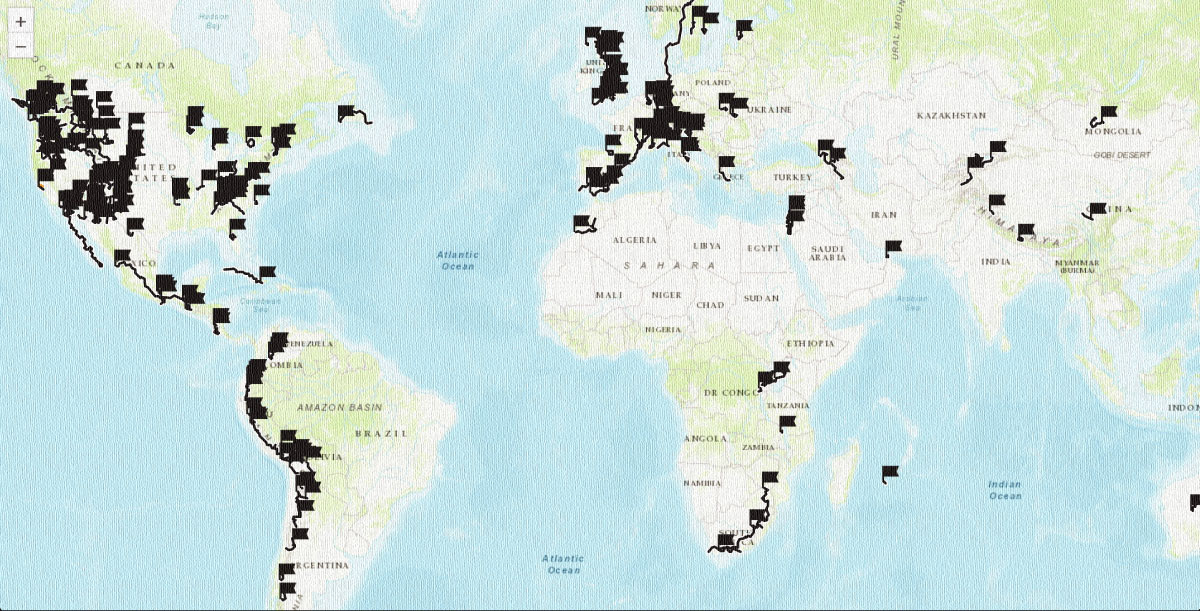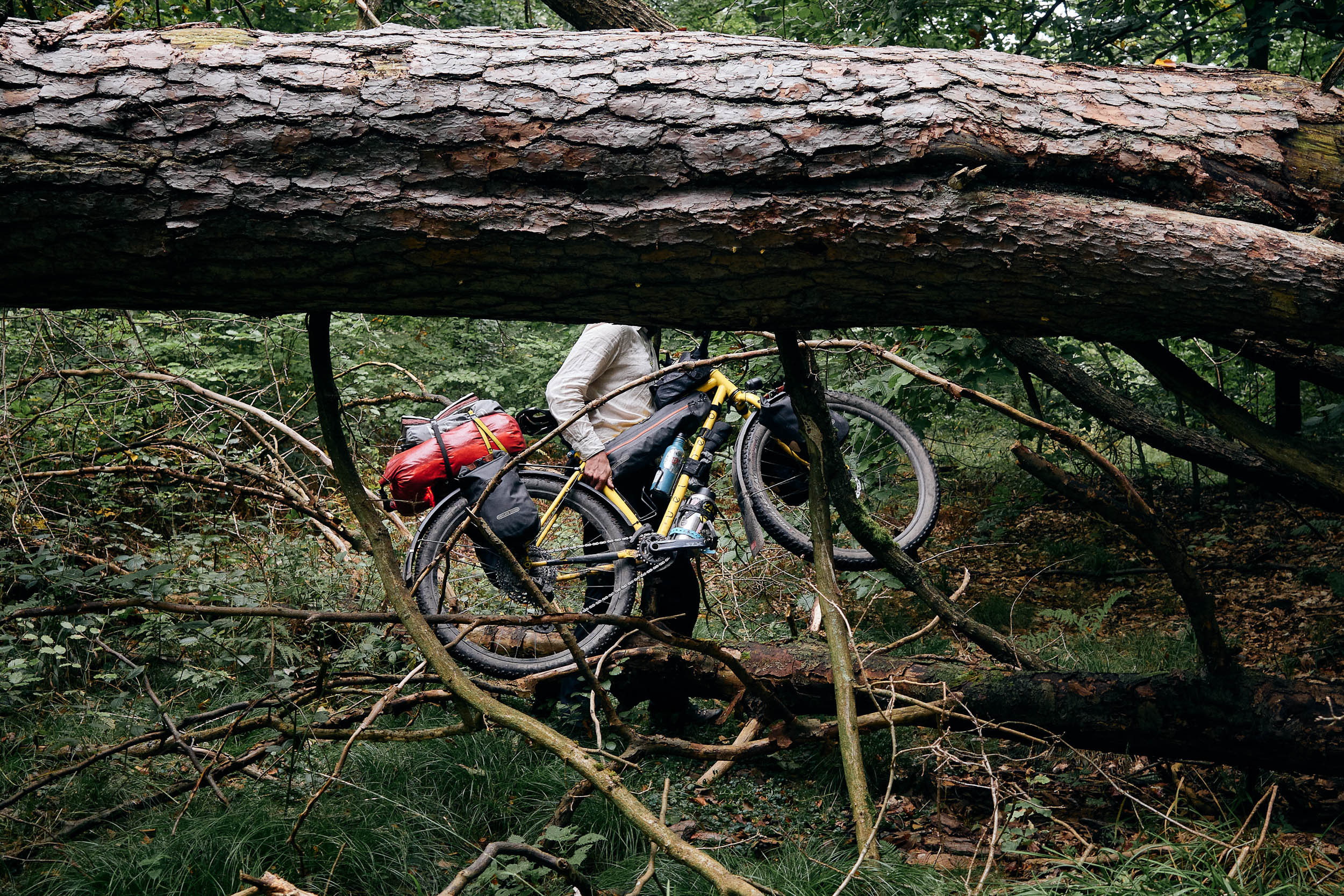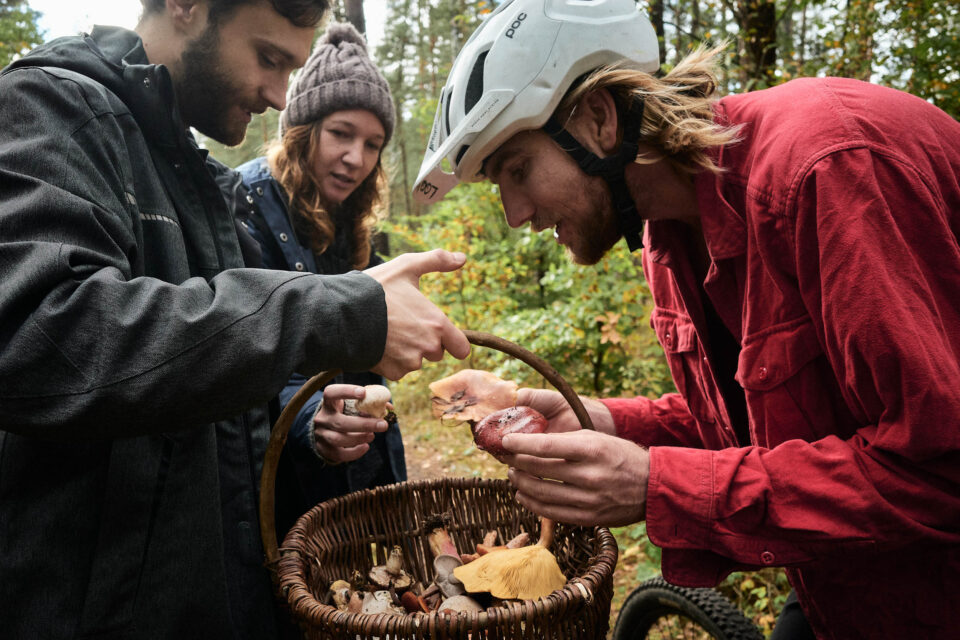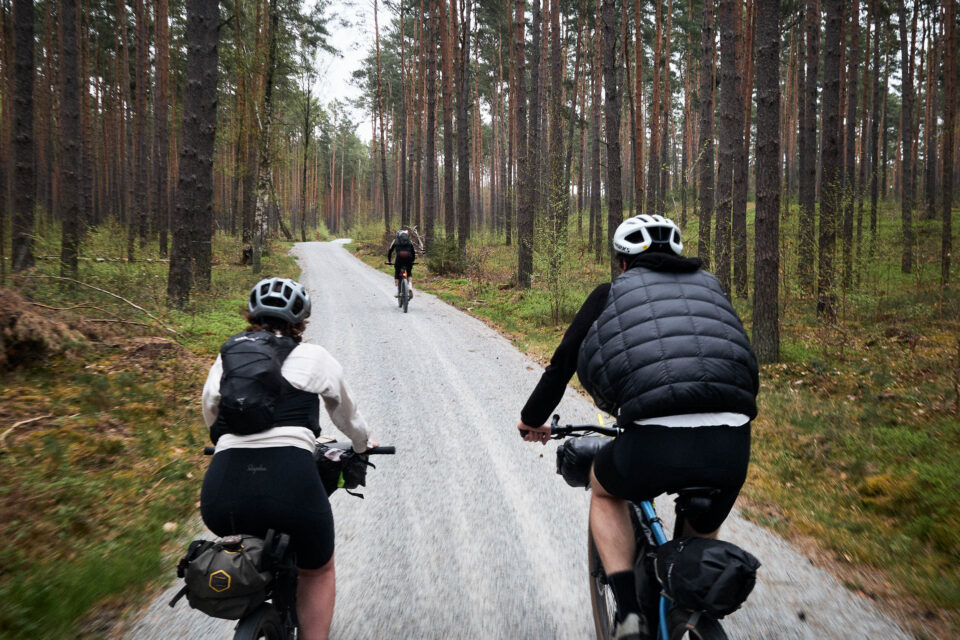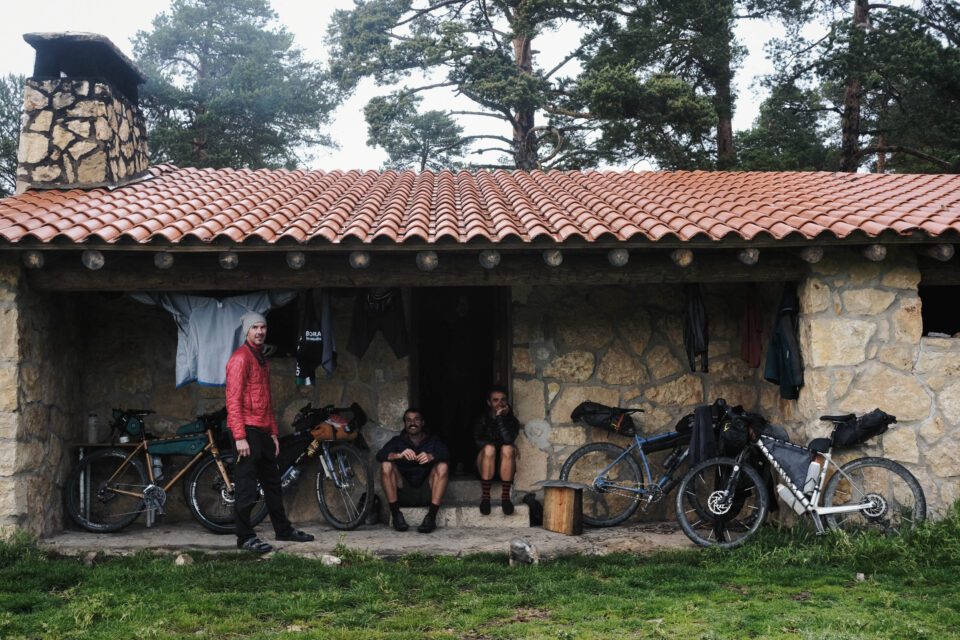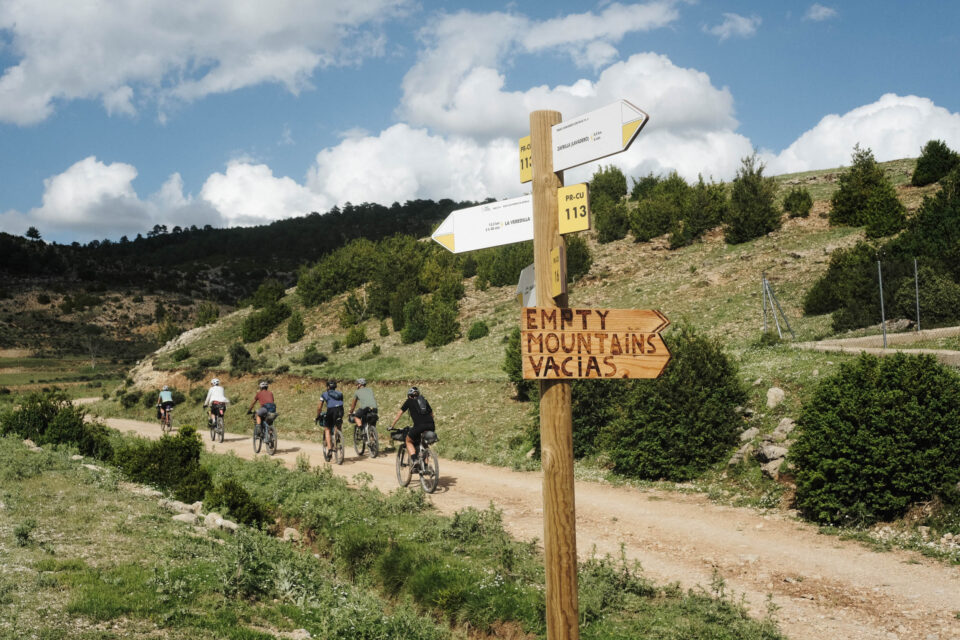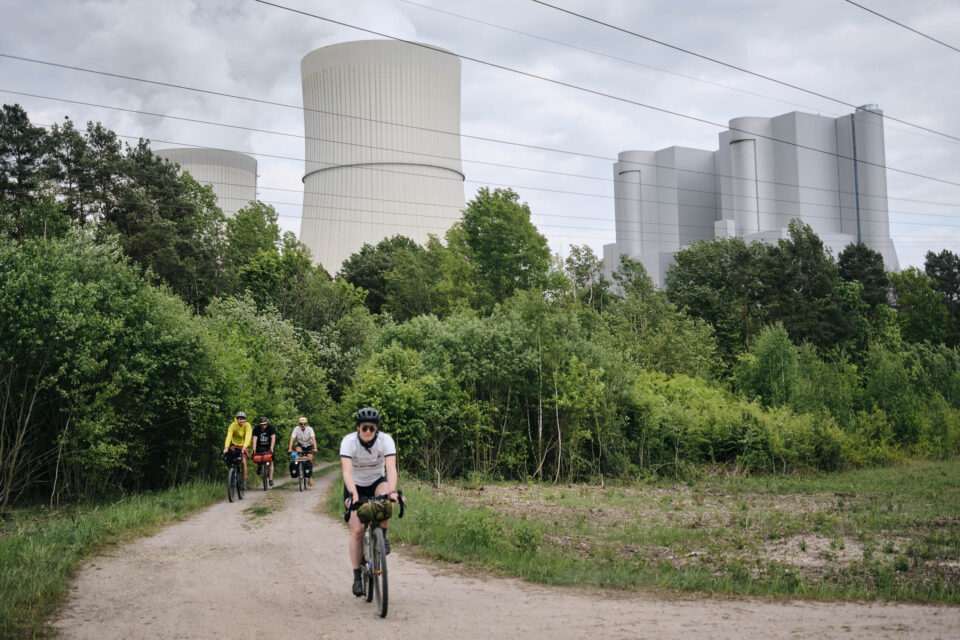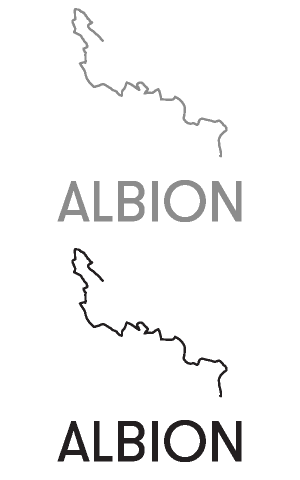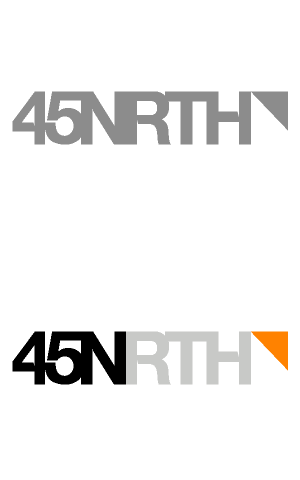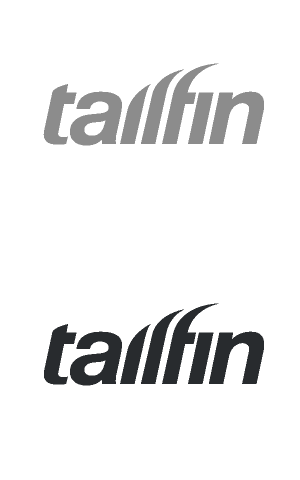When We Get Komooted
Following the sale of the popular route-planning platform Komoot to private equity, Josh Meissner examines the troubling mechanics of the community-powered service beyond its friendly brand image. Using Komoot as an example, he explores the broken relationship between corporate capital and our communities. Amid the tension, discover a way forward that’s available to all of us…
PUBLISHED Jul 25, 2025
Imagine going for a ride on your favorite loop through your local woods and stumbling upon a notice of an impending clear-cut. That’s the shock many of us in the European cycling community felt when the news broke that our trusted route platform, Komoot, was sold to the notorious private equity group Bending Spoons on March 20th of this year. Breaking their promise of long-term commitment to the company, Komoot’s six founders sold out the around 150 employees, millions of active users, and the beloved service, making off with the lion’s share of the 300-million-euro deal.1
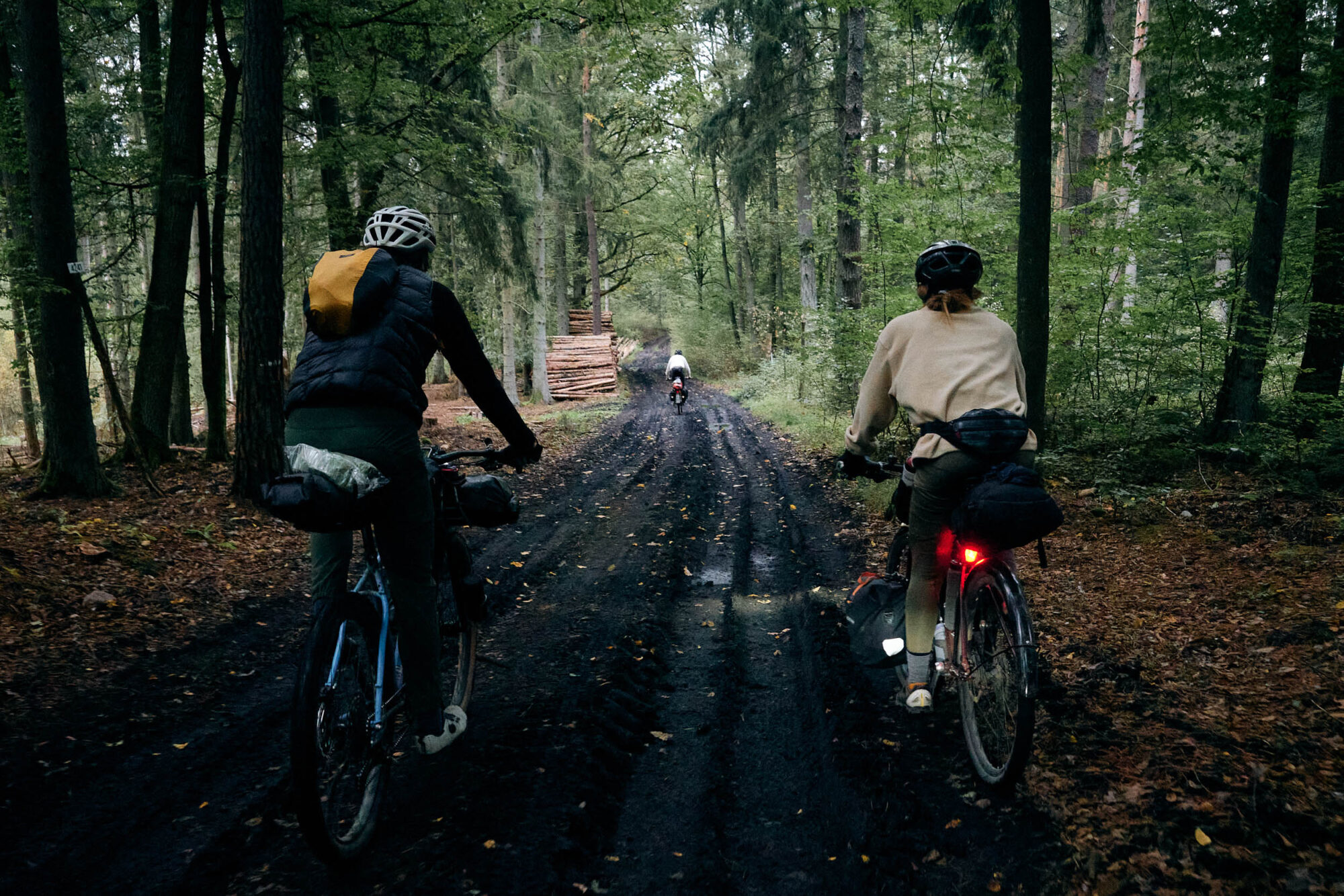
The employees were the first to get the axe. They signed in one morning to learn that the company many had dedicated up to 15 years of their life to was no more. Eighty percent were fired immediately. I spoke with a few longtime employees in the aftermath, who described it as a rough and cruel betrayal.
Komoot, to them, was more than a job; it was a mission and purpose. Many had accepted below-average salaries and uprooted their lives to commit to the outdoor lifestyle and the dream job. Suddenly, they were left scrambling for new work and visa sponsors with just a few months’ pay as severance. The six bosses, meanwhile, pocketed an estimated 20 to 30 million euros each.
Over 45 million of us users, mostly in Europe, were similarly betrayed and left in the dark. Now we hear the chainsaws revving as private equity’s playbook of mass firings, squeezing users, and aggressively monetizing the product starts to play out.2 As users and employees, we’ve been komooted: led astray by capital’s algorithm.
Initial reporting questioned the founders’ decisions, correctly warned of the rapacious new owners, and identified possible alternatives to Komoot. These are important points, but they miss the bigger picture. I’ll argue that Komoot is neither a moral failure nor an outlier but the capitalist system of value extraction working exactly as intended for the platform owners. Whether they’re called Komoot, Strava, AllTrails, or Garmin, for-profit corporations squeeze and sell us out when we give them the opportunity. Corporations we depend on are swallowed all the time. Komoot exemplifies just how much we lose to corporations wielding digital technology encroaching on our communities—and in doing so, we discover the grounds for effective resistance right where we are.
Anatomy of a Rug Pull
In getting komooted, we feel the pain of not being represented in the companies we work for and the platforms we use. Komoot was supposed to be special, the darling of the German startup scene. A unicorn not only in terms of prospective valuation but also in its good working conditions and a progressive mission of enabling access to the outdoors.3 The owners’ assured their long-term commitment with the mantra “we won’t sell.” The abrupt sale stripped Komoot of its green veneer, revealing hard business as usual. Unusually, none of the employees held stock in the startup, deemed unnecessary or “not possible” by the management.4

We shouldn’t be surprised, because capturing communities with false promises only to sell us out is business as usual in the corporate internet. The founders handled the transition horribly, even by tech industry standards, and the pain and disruption it creates in our lives is real. Yet capital is constantly pulling the rug on online communities—the people of Couchsurfing, Reddit, Twitter, and many more were similarly komooted. For corporations, it’s always profits over people.
In financial capitalism, companies themselves become commodities. This pits owners against the people who build the platform in the pursuit of shareholder value. In the official press release of the sale, CEO Markus Hallerman described the 45 million users like a resource that they grew and sold.5 It doesn’t even mention the loyal employees who built the platform into what it is. The new owners, for their part, are “enthusiastic about its future growth potential.” To capital, the corporation is a vehicle for profit; the platform is their plantation. Capitalists see our forests only for their timber value, and they wield the power to impose their limited view on us.6
Unsustainable growth is not just ideology but an imperative, and it’s blatantly unsustainable. In a 2023 interview, Hallerman revealed that Komoot’s revenue was roughly split between recurring subscriptions and new users making one-time payments for map regions, with ad revenue making up a small remainder.7 That means they had to keep signing new users and expanding into new markets to stay in business. Komoot relied on continual growth in a finite world—an impossibility. What cannot continue forever is, by definition, unsustainable.
Driven by the growth imperative, Komoot’s leaders prioritized user base growth and engagement above all else. As I learned, development focused on features that would drive sign-ups and help take over new markets. These ranged from highly compelling features such as the global map with user-generated Highlights and Trail View user photos, algorithmic route recommendations, and human-curated collections, to less savory tactics such as dominating search results with thousands of shoddy algorithmically generated route pages for every destination. Feedback from power users and ambassadors was chronically neglected. The platform was probably approaching a finite user limit in Europe by 2024.8 The sale appears to be a cash-out before growth in Europe inevitably stalled.

Private equity’s business model lies in squeezing the maximum amount of profit from the company until it dies and then throwing it away. Having acquired an expiring business, Bending Spoons immediately started culling the hands who were keeping it alive. They fired the knowledgeable employees with next to no handover and alienated the most passionate users. What’s left is an illusion of a brand, a captive user base, a trove of user data, and a product on life support. Together, a latent infrastructure of extraction and capital accumulation, ripe for intensified monetization.
Enclosure of our commons
Capital does not invent interesting new ideas like gravel and bikepacking. It swoops in from the outside to appropriate. While motley crews in the Midwestern United States organized the first gravel races, and proto-bikepackers charted ambitious off-road routes in the late 2000s, Komoot’s founders conceived the tool as a way to algorithmically find mountain bike trails and jogging routes from a hotel while on a business trip.9 Komoot started as a product by German tech bros for German boomers, and it would have stayed that way if not for the curious dirtbags like us who joined the company over the years. Only they enabled the company to appropriate trends like gravel and bikepacking for mass-market appeal and, along with the communities on the ground, make the owners rich.
Capital generates profits and user base growth, accumulating ever more capital on digital platforms through algorithms that harvest user data. In converting users’ digital productivity into a corporate asset, Komoot exemplifies the workings of capital in the digital landscape. Komoot entices new users by providing ready-made inspiration, frictionless route recommendations, detailed planning, and turn-by-turn instructions in a polished Google Maps-like package. These features rely on tons of our user-generated data—the fuel of the platform. Komoot’s algorithms harvest the routes, points, photos, and notes we create, process them, and present them to other users on the global map, collections, and personal feeds. This so-called inspiration and planning support—digital capital—induces more activity in users and makes the platform more attractive to new ones. More activity generates yet more data and sign-up revenue that keeps the operation running.

Crucially to the business, we users perform this crucial labor for free and without any say in the direction of the platform. This fundamentally extractive relationship between user and platform operator mirrors the relationship between labor and capital, in which business owners turn a profit by extracting surplus value from workers.
To boost engagement and capture groups of users, capital co-opts our human instinct to connect with one another and contribute to a “community” and sells it back to us. As corporations—bureaucratic entities—cannot create value themselves, they instead lure us, social beings, with promises of “community.” In contributing to a corporate “community,” we’re providing free digital labor toward proprietary, engagement-driving features that expand the user base for the profit of the owners. In fact, we suckers even pay for the privilege. Betrayed, we see this “community” for what it is: a mirage.

A useful way of understanding community is as a group that is bonded by a common, a connecting web of shared tangible and intangible goods.10 To us bikepackers, for example, our routes are central, spanning monuments in the United States, South Africa, Thailand, and Spain, to local overnighters and unpublished sketches shared between friends. These labors of love provide targets for each other’s movements and host our races and rallies that bring us together and inspire us to contribute back. They inspire stories that propel us through deserts, mountains, and ice to grow beyond ourselves. Our custom bikes and gear reflect our dirt intentions and we Leave No Trace to keep it all sustainable. Our bikepacking commons weaves us together and forms the grounds of this community.
We all help maintain our commons first and foremost by riding. We thereby forge more-than-human relationships and document and exchange our experiences—these days, mostly digitally. Our gifts to each other go round and round, cycling endlessly like nutrients in a forest—ideally. Riding sprouts new routes, stories, events, connections, and innovations. We’re constantly inspiring, inventing, deriving, sharing, collaborating, branching, and growing back together. It’s incredibly productive. Over time, our commons comes to resemble an abundant old-growth forest. We’ve never needed corporations for community; contributing to the commons is literally in our DNA.
Capital forcibly converts our public commons into its private property in a process called enclosure, commodifying our work. On digital platforms, the corporation controls the means of production and distribution, the grounds of our very real community. They lay claim to the productivity of our commons—in Komoot’s case, users’ routes and photos and local knowledge—and convert it into a corporate asset that fuels their bottom line. Our labors of love become their product, and the quality and complexity drop as the platform churns out cheap and hollow algorithmic commodities. Essentially, they take over our rich old forest and turn it into their for-profit monoculture.
Enclosure by private interests interrupts the fundamental reciprocity of the commons, eroding its abundance over time. After corporate platforms harvest our data, their legal magic prevents it from circulating within our community. The fruits of our labor never re-enter large digital commons like Wikipedia and the OpenStreetMap project, which everyone, including Komoot and Komoot users, benefits from. Instead, it all stays within the corporation’s walls. We, the community that supplied the data, cannot remix and repurpose our collective treasure, for example, to build specific tools and datasets for different activities and regions. This represents a process of continual digital enclosure.

Similarly, Komoot’s core tech of Leaflet map, Graphhopper routing engine, and OpenStreetMap data are all free, open-source projects. This is in addition to all the open-source web servers, databases, and operating systems that tech companies build upon. They leech off the open-source commons, leaving keystone projects underfunded, stagnating with inferior functionality, UX, and security issues.11 Corporations aren’t predators, because predators play a crucial role in maintaining our ecosystems.
Generative AI enables corporations to enclose our knowledge commons, monopolizing our collective knowledge and, again, selling it back to us. Virtually all tech companies, including Komoot, are racing to integrate generative AI into their platforms, as it represents a generational opportunity to enclose all publicly available knowledge within their walled gardens. As if that weren’t enough, major AI companies go further by allegedly illegally training the large language models on copyrighted content at an industrial scale.12,13,14 This upends the already marginal livelihoods of authors, creators, and independent publications, eradicating keystone species from our forests. Then they force us into monthly payments to access our shared knowledge commons.
I assume user data and other adventure resources will be piped into the Komoot adventure chatbot. It’s fully in line with the idea of algorithmic routes and Bending Spoon’s strategy. On July 1st, 2025, WeTransfer, another company acquired by Bending Spoons, quietly changed its terms of service to allow for training AI models with user data, similar to recent attempts by Adobe, Zoom, Dropbox, and Slack. The company backtracked after severe customer backlash, but the intent and the systematic contempt for the user/rightholder are clear. Now’s the time to export data and close accounts, because once data is in the model, it’s stolen for good.
Digital enclosure is the continuation of the physical enclosure of land. This sophisticated form of digital extraction is so common that it’s almost unremarkable. But there’s a wrenching contradiction here between Komoot’s stated mission of “enabling access” to public land while privatizing and exclusively profiting from those very movements. They take our most meaningful encounters with nature and ourselves and sell them back to us for a quick buck. Komoot? Nein, danke.
This digital enclosure goes back to the violent enclosures of the commons and Indigenous land, and the expropriation of millions of commoners and Indigenous people that launched early capitalism and colonialism in the 16th century.15 The extractive, exploitative scheme continues as gentrification in our cities and the sell-off of the public land that we recreate on.16 In platform capitalism, we’re similarly expropriated of our digital common land.

Enclosure has a cultural dimension. It turns our rich old-growth commons into thin monoculture plantations. The singular profit motive kills diversity and homogenizes scenes, packaging, branding, and selling our culture back to us. We feel the vibe shift when corporations infiltrate our spaces. Clothing and equipment choices standardize, our squiggly routes start fitting the platforms’ templates, events must be televised, and our media is brand-safe. We get ever further out there, while growing more distant from each other and the world. We’re shilling gear and optimizing content and selling our adventures as a product. We’re trying to live the dream and get back to the forest we find ourselves working for the great lumber mill that is capital.
Riding bikes remains beautiful, despite being subsumed by capital. The original magic can still be found in less-managed stands like zines, campouts, non-commercial events, and, thanks to reader support, on BIKEPACKING.com. These are essential sanctuaries where we hold out, creating and connecting more authentically.17 But even these remaining stands are constantly pressured. Few of us have seen true old-growth.
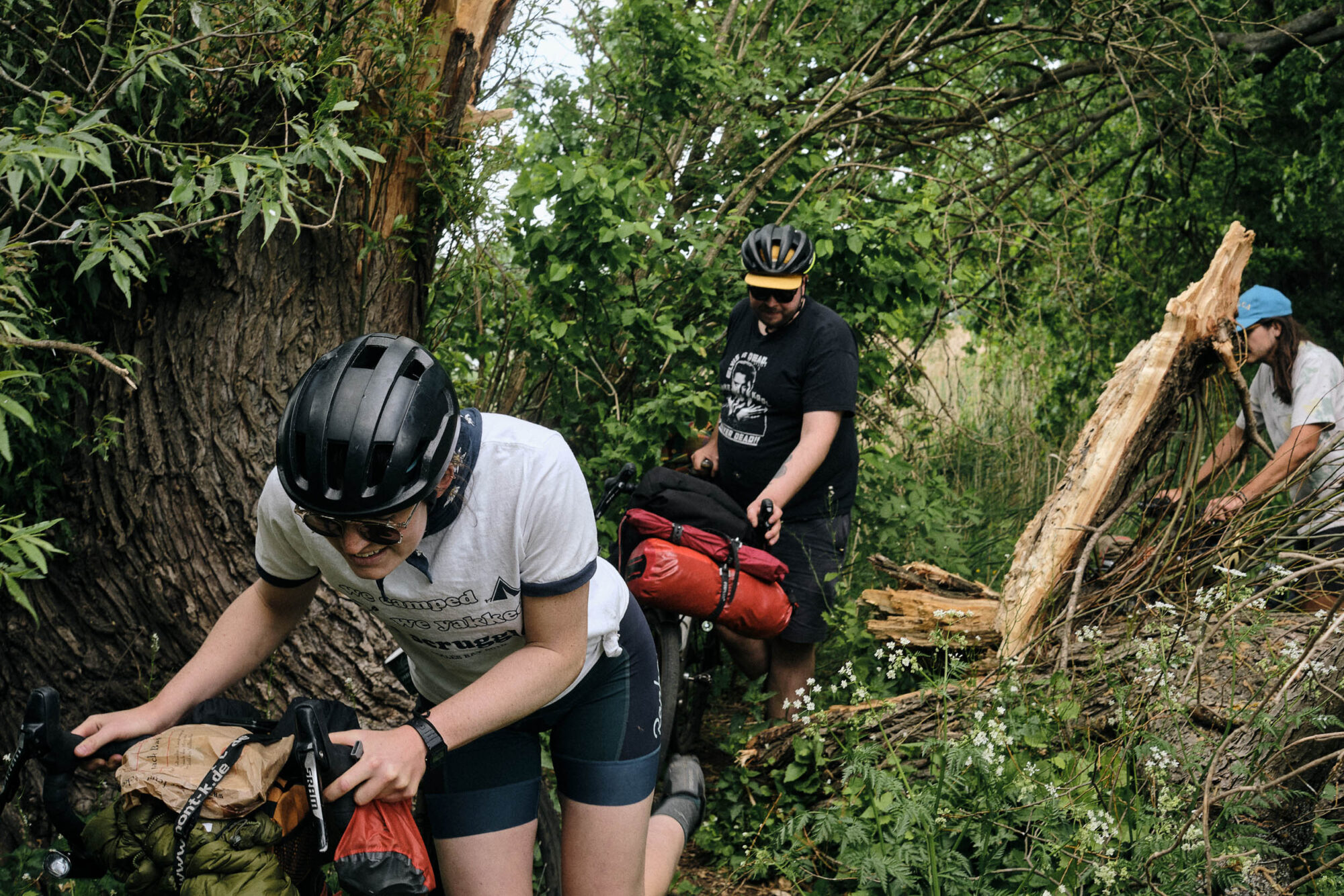
Corporate capture poses a mortal risk to our communities. When our platforms, blogs, route authors, storytellers, organizers, and events depend on corporate deals, we’re letting the lumber mill own parts of our forest.18 We’re tied to the whims of executives and the shocks of the broader capitalist economy. Large swaths of our community are at risk of being komooted.
Operation Enshittification
Popularized by writer and activist Cory Doctorow, enshittification describes the bait-and-switch that unfolds on corporate platforms from happy early days to overt abuse of the customer base in pursuit of profit and shareholder value.19 The recent rug pull is not the beginning of Komoot’s decline. It’s merely the apex of a depressing trajectory followed by practically all corporate platforms in the enshittocene. As Bending Spoons needs to recoup their outlandish investment, the predictions offered by the theory of enshittification are already coming true.20
In the first stage of enshittification, the platform offers a lot of value so users join the platform and enliven it with their productivity. Historically, Komoot wasn’t bad to its users as far as tech companies go, creating a friendly, trustworthy image. A one-time payment, subsidized by the user’s data, unlocked substantial functionality and access to features many found useful. They didn’t sell user data to third parties, and ads and sponsored content were contained to the feed. Kept in check by mission-driven employees, bosses cannot implement features that detract from the product or abuse users too much. But after the mass firing, a major counterbalance is removed.
Once constraints on the corporation are lifted, platforms turn to pure rent-seeking—direct extraction of money without creating real value to users. The deal between the corporate platform and the users can and will be continuously altered to the owner’s advantage, degrading the user experience. Komoot is in the process of being enshittified like the Bending Spoons acquisitions WeTransfer and Evernote. Core features such as Garmin and Wahoo integration have been placed behind a paywall for new users. “Creative” friction is being introduced on free usage, as pioneered in WeTransfer’s gutting. Komoot users are being pushed toward pricier weekly plans; Evernote’s subscription price effectively doubled following the takeover. “Lifetime” access has been revoked on numerous other services.21
To further boost revenue, the owners may seek to attract more business customers, likely at the expense of existing users. This could involve more sponsored collections and ads not only in the feed but also throughout the product—billboards among trees. Selling user data to third parties would enable more lucrative targeted ads.

The corporation is always a vehicle for generating profit and capital accumulation, always in conflict with the interests of the user base. In the terminal stage of enshittification, this fundamental misalignment between the owners and users becomes painfully overt as the platform nags and abuses us on every screen. Yet we were being subtly exploited from the beginning.
Corporate platforms aim to capture users through any available means to maximize value extraction in the terminal stage of enshittification. When the platform becomes too overbearing or ceases to be useful, we’ll simply stop using it. To keep us on the platform, working for the owner’s profit, they capture us by exploiting our human need for connection and community. We struggle to break free when we stand to lose our social circle and proprietary convenience. But while Komoot has social elements, it remains a dorky route planner, not a social network like Facebook or Instagram. And if creating and sharing routes and riding bikes with friends is what it’s all about, that’s possible whether we’re paying Komoot or not.
Instead, Komoot holds our planning, documentation, and memories hostage to keep us trapped on the platform, providing free labor for the corporation. More restrictive than even the likes of Google and Strava, it’s not possible to batch export your own tracks, points of interest, photos, and notes directly from Komoot.22 A button to batch download your own GPX tracks in human-friendly formatting was temporarily added and then removed again a few weeks before publication. Requesting a data export via email in accordance with GDPR yields a practically useless data dump.23 Our community export tools provide an imperfect workaround for what should be bare minimum native functionality.
Ultimately, enshittification is a sophisticated scheme employed by profit-hungry tech corporations that maximizes value extraction as they invade our individual lives and communities relatively unchecked. The platform initially provides a lot of genuine value to users, luring us in to fill it with life. Then the mask is dropped and all value is clawed back, squeezing captive users in pursuit of profit and shareholder value. They degenerate into low-quality, ad-infested purgatory and are shut down after capital has extracted maximum value—the clear-cut.
Corporations don’t die like natural organisms. The wealth they extract isn’t recycled. But the scars on our lives and our commons are permanent.
No Other Land
We begin to see that the next corporate platform courting our favor is nothing but another trap. We cannot outfox organized capital with our individual choices. Underneath the marketing veneer and despite the best intentions of employees and possibly some owners, all corporate platforms are just different profit-seeking vehicles of capital. Corporations cannot be our friends or part of our community as they indifferently co-opt, enclose, and extract from our commons until there’s nothing left.

Yet the clear-cut also contains the seeds of the next old-growth community. At this moment, a rewilding of the internet is occurring in many places. A decentralized movement toward open, cooperative platforms that support real community, rather than zero-sum corporate walled gardens.24 Promising projects such as the Mastodon social network, Matrix chat, and Pixelfed social photo sharing are reviving the diversity and abundance of the early, independent internet before it was enclosed by tech giants in the 2010s. More than singular platforms, the Fediverse represents a growing ecosystem of open protocols and distributed services that guarantee freedom of movement for users and data and push back against capitalist enclosure—a diverse and resilient digital commons.
Komoot’s the latest wrenching reminder that corporate platform monopolies don’t work for communities. We need open-source, non-profit platforms that are owned and governed by the people. Enduring digital sanctuaries that are resistant to individual control and never up for sale, so we can build on them and benefit sustainably with material assurance. Wanderer.to is one such fledgling pioneer, still rough around the edges and missing many features, but Komoot also wasn’t built in a day. We’ll need different tools for our many niches, which flourish together through federation and interoperability.
Rebuilding polished corporate platforms in the public domain is no doubt an ambitious challenge. But Komoot, for all its flaws, is proof that we can and must do it. Employed and non-employed contributors, we created real value for millions of us, despite the commercial constraints. Painfully for us, capital compromised that project from the start. But we have the talent and experience in our ranks, and capital does not. We know how to organize ourselves better to avoid another komooting. Difficult work for the betterment of the community is just what we do.
The fight for digital justice is not more important than fighting ecocide, genocide, war, fascism, and the climate emergency. But as Cory Doctorow writes, “Free, fair, open tech is a precondition for winning those other fights. Winning the fight for better tech won’t solve those other problems, but losing the fight for better tech extinguishes any hope of winning those more important fights.”25

In understanding our community as coupled to the health of our commons, we begin to see other commons and communities in the world also under fire. The forces that enclose our routes and knowledge and culture are the same forces that enclose public land for industrial logging and mining and farming. Our digital commons will flourish when we dismantle the system that creates monocultures, coal plants, and hydro dams. We start to see that these are connected struggles—we fight for equitable and abundant old-growth everywhere. We form one ardent, solidaric front that fights for each and all life on the commons of Planet Earth.
Our routes, our events, our gear, our stories, our media, our platforms, our organizations, our people—we critters of the forest draw from and contribute to our commons whether we know it or not. It’s the grounds that launch our most ambitious journeys and the grounds that catch us on return. It’s the grounds of our community, the grounds that make our very selves. Against the extractive forces of capital, our commons need our redoubled, material protection. Because only through our commons are we able to do this most meaningful work—constantly regenerating our commons, and thereby ourselves, without corporations in the way. All day, every day, we’re doing it already.
Big thanks to my friend Michael and the bikepacking commons for helping me find my way and these words. ChatGPT was used to parse Komoot’s terms of service and privacy policy.
Works Cited
Please keep the conversation civil, constructive, and inclusive, or your comment will be removed.


